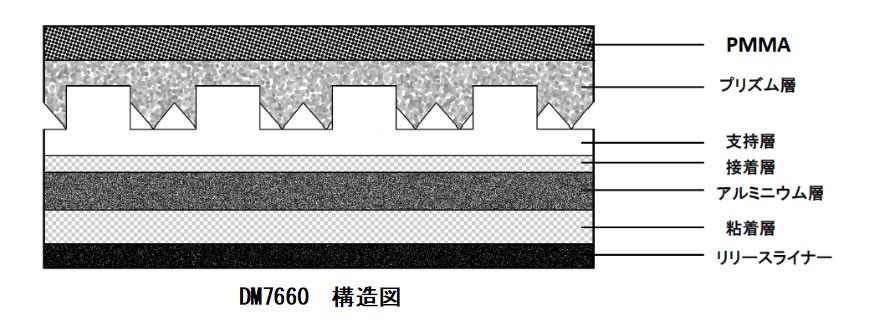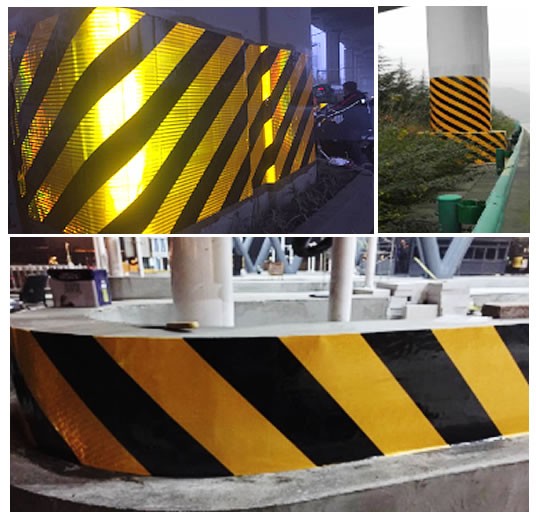Product Overview
DM7660 High Intensity Aluminum-Based Prism-Type High Brightness Reflective Sheet is a micro-prism-type reflective sheet based on a highly flexible aluminum layer. Taking advantage of the easily deformable aluminum layer's characteristics, this product has improved the adhesive performance of the reflective sheet. It is ideal for use on highways and general roads, as well as viaducts, bridges, electrical equipment, etc. (especially concrete surfaces).

- Structure: PMMA (acrylic resin) microprism structure
- Weather resistance: 10 years (Xenon lamp weather resistance test 1800 hours)
- Size: 1.22 x 45.7m/roll, 0.61 x 45.7m/roll
- Color: White, Yellow/Black, White/Red,
- Processing method: Screen printing, die cutting
- Applications: Ideal for highway signs, traffic signs, crossing signs, etc. on concrete surfaces
- International standards: ASTM D4956 Type IV, EN12899-1, RA2, KS A 3507 Type 4, AS/NZS 1906.1:2007

- Flexibility and plasticity: The deformation of the aluminum layer significantly reduces the restoring force of the reflective sheet after bending
- Adhesion: Excellent pressure sensitive adhesive performance
- Seawater resistance: High seawater resistance is achieved by preventing air from penetrating from the base layer into the interior
Product Storage
Please use this product within one year of purchase.- Store aluminum-based film products in a dry, clean, well-ventilated place. Store in a low-humidity location free of corrosion-resistant substances such as acids and alkalis, avoid direct sunlight, and store at least 2 meters away from heating equipment.
- Maintain an optimal indoor temperature of 5 to 35°C and humidity below 70%. To ensure optimal adhesive performance of aluminum-based film products, store them in an environment between 20 and 28°C for 24 hours before use.
- Reflective sheeting products should not be stored in stacks of more than six layers, and different sizes of sheets should not be stored together.
Procedure
- Surface preparation Aluminum-based film products are ideal for application on concrete surfaces such as bridge piers, curbs, and tunnel entrances. Moisture, chemicals, dirt, dust, and burrs on the concrete surface can reduce the adhesion of the film, so be sure to remove them thoroughly before application. When polishing the concrete base, first polish off the burrs to make it smooth, completely remove any surface dirt, and wipe thoroughly with a damp cloth.
- Proportion of primer (DM PC-150) and thinner
- After cleaning the base, apply DM PC-150 (primer) to the concrete surface.
- DM PC-150 should be diluted 1:1 with thinner before use.
- Precautions before applying the film
- Please double check that the concrete surface has been properly prepared.
- Ensure that the work area is clean and that all work tools are in order.
- Care is taken to ensure that the film patterns and orientation are properly aligned.
- The film should be bonded to the dry substrate within 5 minutes of removing the release paper.
- Film attachment work
- Place the film along the concrete surface, hold one side of the film and peel off about 40 cm of the release paper (cut or fold the peeled release paper). At this stage, do not stick the film to the concrete surface yet.
- After removing the release paper, apply moderate pressure to the film and concrete surface, being careful not to wrinkle the film when attaching it.
- Using a moderately hard scraper, slowly peel off the release paper while applying it in a circular motion. For surfaces larger than 60cm square, apply the film smoothly from the center to both sides while removing air bubbles. Apply moderate pressure and move the scraper in three directions.
- When you have finished installing the film, use a scraper or similar tool to firmly press the film onto the corners of the concrete.
- Finish by moistening a clean cotton cloth with volatile oil and wiping off any dirt on the film surface.
- trimming
- Before trimming the film, use a scraper to ensure proper adhesion of the film to the corners of the concrete surface.
- When trimming, use a cutting knife or other stainless steel knife as close to the application surface as possible. Keep the knife at a 30° angle to the film and cut in one go.

Weather resistance of reflective materials
The description of the assessment procedure and years of use are based on the manufacturer's knowledge and practical experience. This data is intended only as a source of information and is provided without warranty and does not constitute a guarantee. Since applications under various circumstances are possible, the customer must independently determine the suitability of this material for a particular purpose before use. We cannot be held responsible (monetary compensation, etc.) for any damages arising from the purchase or use of the product.
